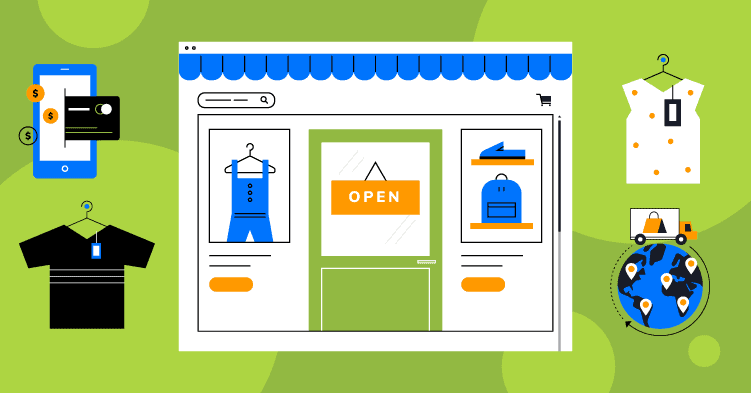A Small Business Guide to Shopify
Adaptation: that’s how small businesses survived – and even thrived – during the pandemic.
Real-world shops and services moved online. Ecommerce businesses diversified, refining their shopping experience to stay competitive.
The answer for many of these small businesses was a service you’ve probably used as a consumer without realizing it: Shopify.
Shopify is a direct-to-consumer (D2C) subscription service that enables entrepreneurs to set up websites, receive online payments, and ship/track customer orders. It also has powerful marketing and analytics tools built-in.
The company’s revenue nearly doubled to $714.3 million during the first quarter of mass international lockdown. But Shopify’s businesses reaped the rewards: for every buck Shopify made, its merchants generated $40.82.
Plus, in a time of mass layoffs, “businesses on Shopify supported approximately 1.5 million more jobs in 2020 than they had in 2019,” according to a study from Deloitte.
The Shopify Strategy for Small (and Big) Businesses
It’s not only small businesses that changed tack in 2020. The giants led by example.
By supercharging its shift to D2C, Nike saw its quarterly sales spike by 75% to just under $2bn in the early months of the pandemic.
As Nike’s hosts at Shopify put it: “Basically, if you can figure out what Nike’s doing with their omni-channel ecommerce strategy… You can do it faster, and cheaper.”
The strategists at Nike – primarily an athleisure and branding company – figured out years ago that the company would need to bypass third-party stores if it was to connect with contemporary consumers and survive in a post-mall world.
Nike was slowly rolling out its “Consumer Direct Offense”, but moved quickly to capitalize on its ‘intangibles’ when the pandemic forced many of its 900 bricks-and-mortar stores to close. Those intangibles? Content, analytics, community – and its Shopify-powered D2C platforms.
“It was definitely architecting a new retail, and a bold, retail vision for Nike,” said Heidi O’Neill, Nike’s president of consumer and marketplace (and former President, Direct to Consumer). “But it started with our consumer, and we knew that consumers wanted a more direct relationship with us today.”
Setting Up Shop on Shopify
While many of Shopify’s merchants are big names (including some who got started on Shopify), most are first-time entrepreneurs.
Shopify itself grew out of an indie snowboard retailer – the company’s founders couldn’t find an ecommerce solution that worked for them, so they started Shopify.
So, you can expect a service that makes it as easy as possible to sell (including internationally), market, and strategize the online arm of your small business. Subscription begins at $29/month, and all essential functionality is included even in this Basic package.
You can set up your online store on your own domain name or with a custom Shopify URL. There are free or paid themes to shape your customers’ visual experience, and you can also customize colors, fonts etc. It’s important (and fun) to create a pleasant, uniquely branded storefront – but it’s just as important to include all necessary details and processes for a smooth checkout.
Depending on how many lines you sell, adding products to your store may be the most time-consuming part of setting up. But there are ways to make the process faster, as well as plug-in style apps to streamline every task. Finally, you can begin to market your channel and connect it through other platforms such as your Facebook and Google profiles.
OnDeck has created a thorough new walk-through guide for small businesses getting started on Shopify. Just as importantly, we’ve included insights and tips to bring customers to your store and ensure they keep coming back.
As the new future of retail dawns, Shopify is an essential tool to help your small business adapt to all the ebbs and flows. Here’s how to open up shop – and keep it open.

Sources
- Holmes, T. (2021). Statistics and figures about Shopify. shopifyandyou.com
- Shopify. (2021). About Us. shopify.com
- Thomas, L. (2020). Shopify Statistics (Market Share, Revenue, Sellers & More). hostsorter.com
- McKinnon, J. (2019). The Top eCommerce Platforms of 2019 Compared. pagely.com
- Shopify. (2021). Plan features. shopify.com
- Shopify. (2021). Pricing. shopify.com
- Kumar, B. (2021). How to Start an Online Store with Shopify: A Step-by-Step Guide. shopify.com
- Hoang. M. (2021). How to Sell on Shopify – A Definitive Beginner’s Guide (Updated 2021). beeketing.com
- Renée, S. (2021). Want to Rank Your Store? Get On Page One With This SEO Checklist. shopify.com
- Radd Interactive. (2021). How to Add a Sitemap to Google Search Console (Step-by-Step). raddinteractive.com
- Google. (2021). Use Keyword Planner. google.com
- Duistermaat, H. (2019). 9 Ways to Write Product Descriptions that Inform and Persuade Your Customers. shopify.com
- Ong, S.Q. (2020). Shopify SEO: 10 Easy Tips For More Organic Traffic. ahrefs.com
- Shopify. (2021). Adding alt text to media. shopify.com
- Amoah, K. (2018). 10 Shopify SEO Mistakes You Should Avoid In 2020. kudobuzz.com
DISCLAIMER: This content is for informational purposes only. OnDeck and its affiliates do not provide financial, legal, tax or accounting advice.



